Attached files
| file | filename |
|---|---|
| 8-K - FORM 8-K - WCI Communities, Inc. | d125999d8k.htm |
| EX-99.1 - EARNINGS PRESS RELEASE ISSUED BY THE COMPANY ON FEBRUARY 17, 2016 - WCI Communities, Inc. | d125999dex991.htm |
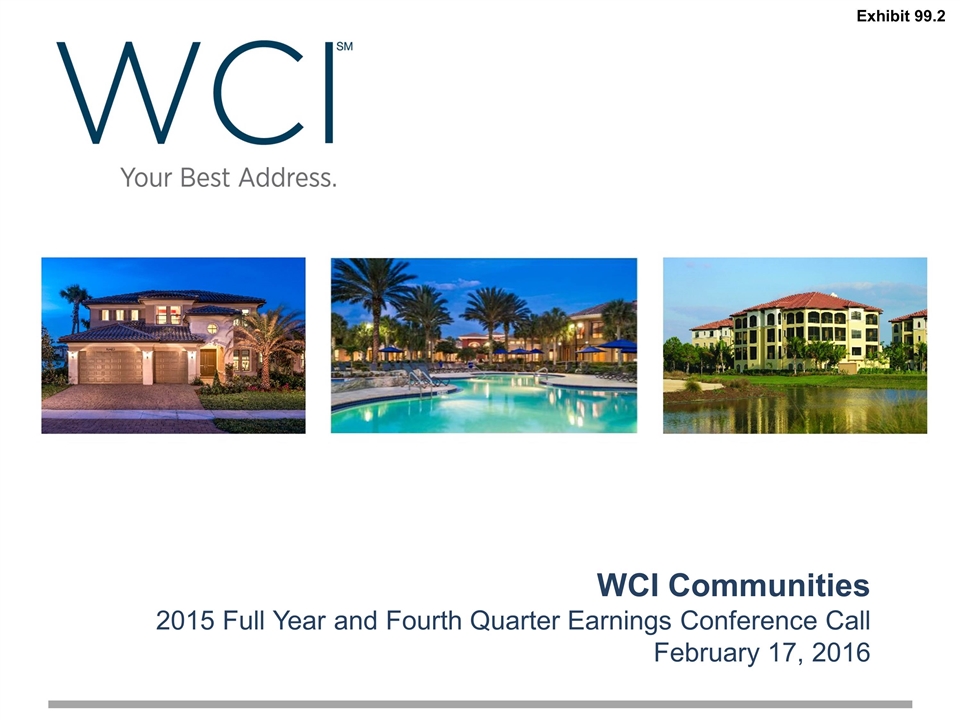
WCI Communities 2015 Full Year and Fourth Quarter Earnings Conference Call February 17, 2016 Exhibit 99.2
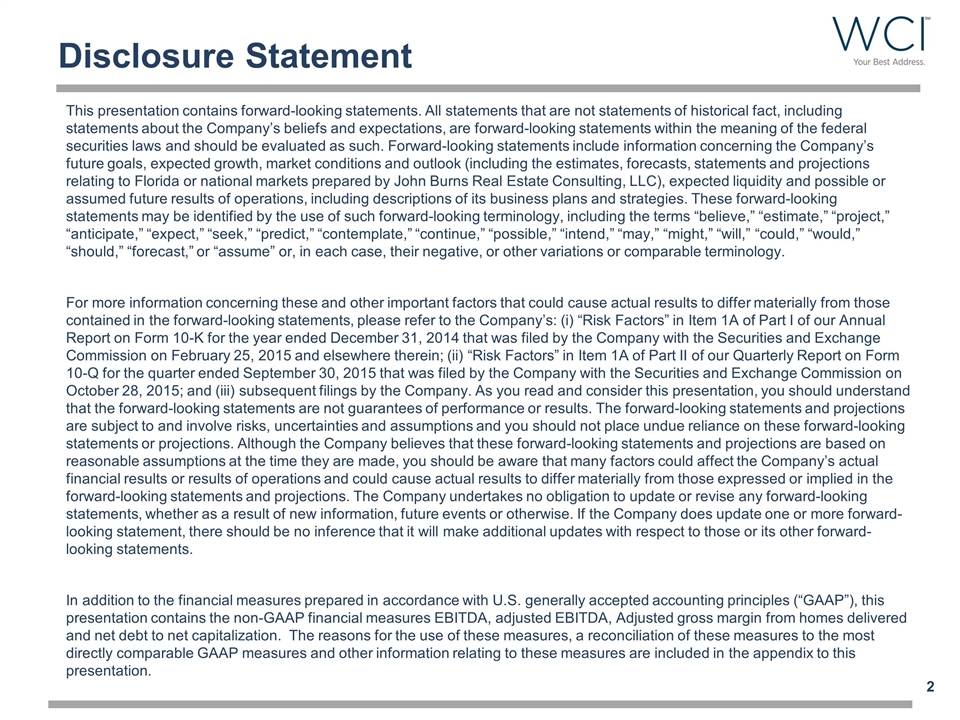
Disclosure Statement This presentation contains forward-looking statements. All statements that are not statements of historical fact, including statements about the Company’s beliefs and expectations, are forward-looking statements within the meaning of the federal securities laws and should be evaluated as such. Forward-looking statements include information concerning the Company’s future goals, expected growth, market conditions and outlook (including the estimates, forecasts, statements and projections relating to Florida or national markets prepared by John Burns Real Estate Consulting, LLC), expected liquidity and possible or assumed future results of operations, including descriptions of its business plans and strategies. These forward-looking statements may be identified by the use of such forward-looking terminology, including the terms “believe,” “estimate,” “project,” “anticipate,” “expect,” “seek,” “predict,” “contemplate,” “continue,” “possible,” “intend,” “may,” “might,” “will,” “could,” “would,” “should,” “forecast,” or “assume” or, in each case, their negative, or other variations or comparable terminology. For more information concerning these and other important factors that could cause actual results to differ materially from those contained in the forward-looking statements, please refer to the Company’s: (i) “Risk Factors” in Item 1A of Part I of our Annual Report on Form 10-K for the year ended December 31, 2014 that was filed by the Company with the Securities and Exchange Commission on February 25, 2015 and elsewhere therein; (ii) “Risk Factors” in Item 1A of Part II of our Quarterly Report on Form 10-Q for the quarter ended September 30, 2015 that was filed by the Company with the Securities and Exchange Commission on October 28, 2015; and (iii) subsequent filings by the Company. As you read and consider this presentation, you should understand that the forward-looking statements are not guarantees of performance or results. The forward-looking statements and projections are subject to and involve risks, uncertainties and assumptions and you should not place undue reliance on these forward-looking statements or projections. Although the Company believes that these forward-looking statements and projections are based on reasonable assumptions at the time they are made, you should be aware that many factors could affect the Company’s actual financial results or results of operations and could cause actual results to differ materially from those expressed or implied in the forward-looking statements and projections. The Company undertakes no obligation to update or revise any forward-looking statements, whether as a result of new information, future events or otherwise. If the Company does update one or more forward-looking statement, there should be no inference that it will make additional updates with respect to those or its other forward-looking statements. In addition to the financial measures prepared in accordance with U.S. generally accepted accounting principles (“GAAP”), this presentation contains the non-GAAP financial measures EBITDA, adjusted EBITDA, Adjusted gross margin from homes delivered and net debt to net capitalization. The reasons for the use of these measures, a reconciliation of these measures to the most directly comparable GAAP measures and other information relating to these measures are included in the appendix to this presentation.
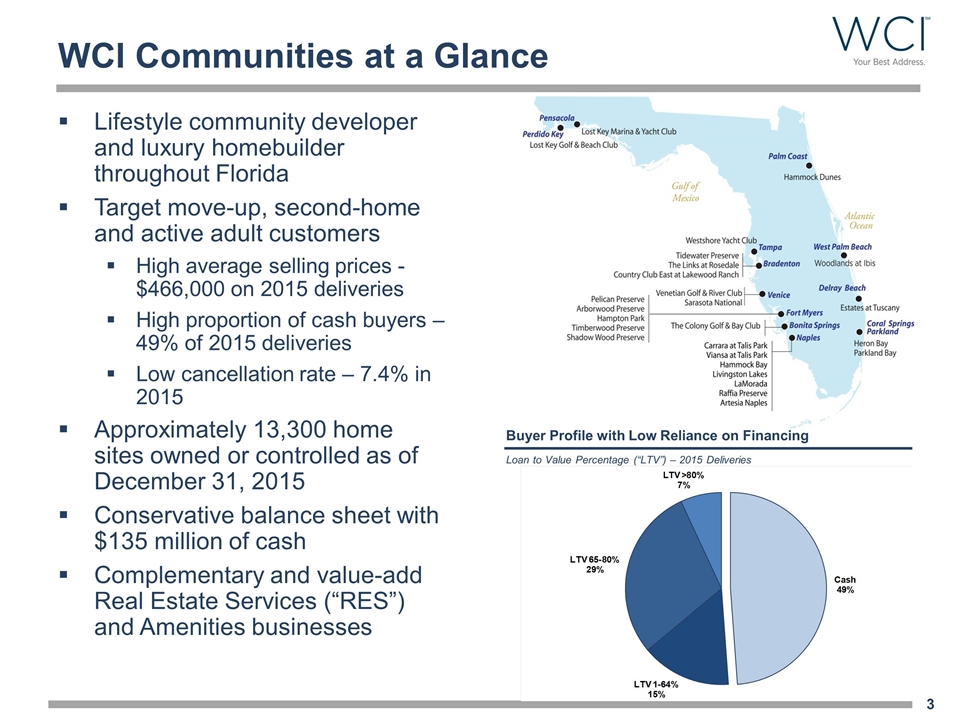
Loan to Value Percentage (“LTV”) – 2015 Deliveries WCI Communities at a Glance Lifestyle community developer and luxury homebuilder throughout Florida Target move-up, second-home and active adult customers High average selling prices - $466,000 on 2015 deliveries High proportion of cash buyers – 49% of 2015 deliveries Low cancellation rate – 7.4% in 2015 Approximately 13,300 home sites owned or controlled as of December 31, 2015 Conservative balance sheet with $135 million of cash Complementary and value-add Real Estate Services (“RES”) and Amenities businesses Buyer Profile with Low Reliance on Financing
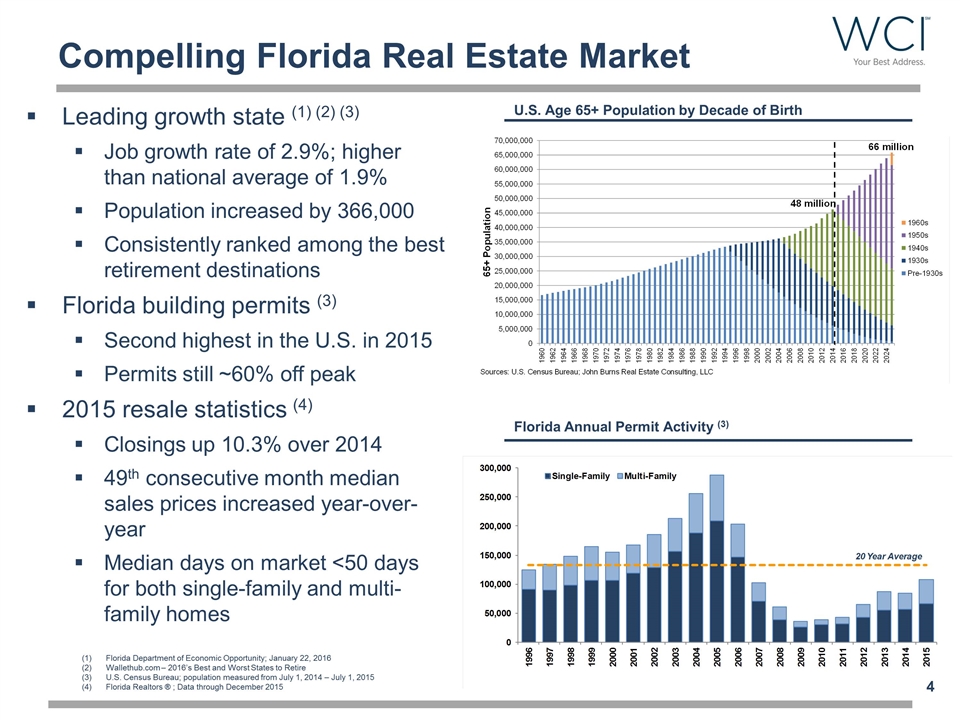
Compelling Florida Real Estate Market Leading growth state (1) (2) (3) Job growth rate of 2.9%; higher than national average of 1.9% Population increased by 366,000 Consistently ranked among the best retirement destinations Florida building permits (3) Second highest in the U.S. in 2015 Permits still ~60% off peak 2015 resale statistics (4) Closings up 10.3% over 2014 49th consecutive month median sales prices increased year-over-year Median days on market <50 days for both single-family and multi-family homes Florida Department of Economic Opportunity; January 22, 2016 Wallethub.com – 2016’s Best and Worst States to Retire U.S. Census Bureau; population measured from July 1, 2014 – July 1, 2015 Florida Realtors ® ; Data through December 2015 Florida Annual Permit Activity (3) U.S. Age 65+ Population by Decade of Birth
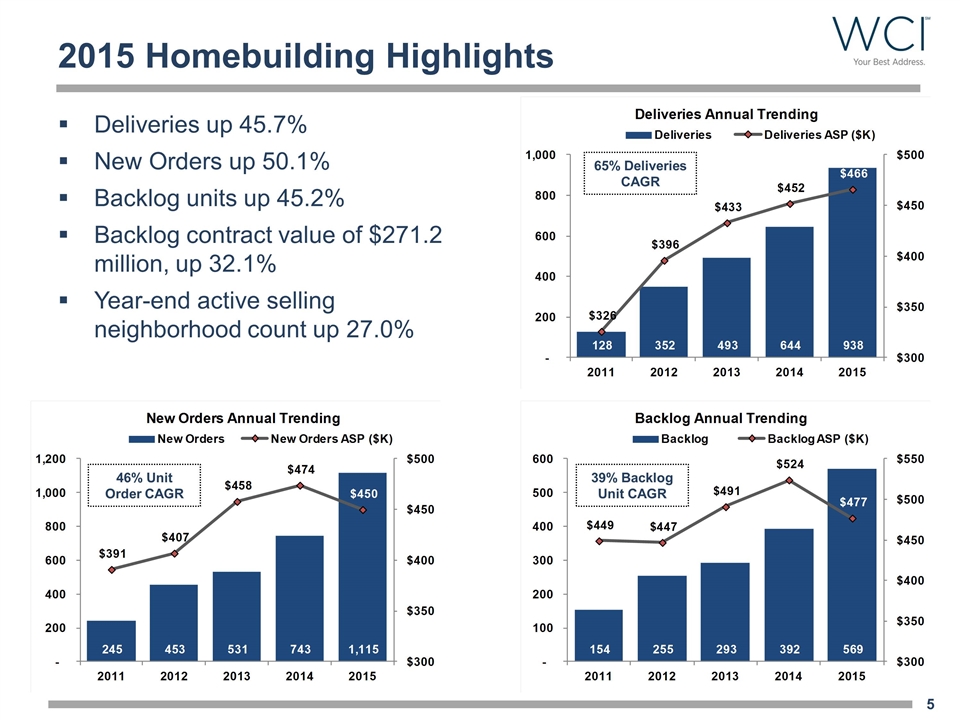
2015 Homebuilding Highlights Deliveries up 45.7% New Orders up 50.1% Backlog units up 45.2% Backlog contract value of $271.2 million, up 32.1% Year-end active selling neighborhood count up 27.0% 46% Unit Order CAGR 65% Deliveries CAGR 39% Backlog Unit CAGR
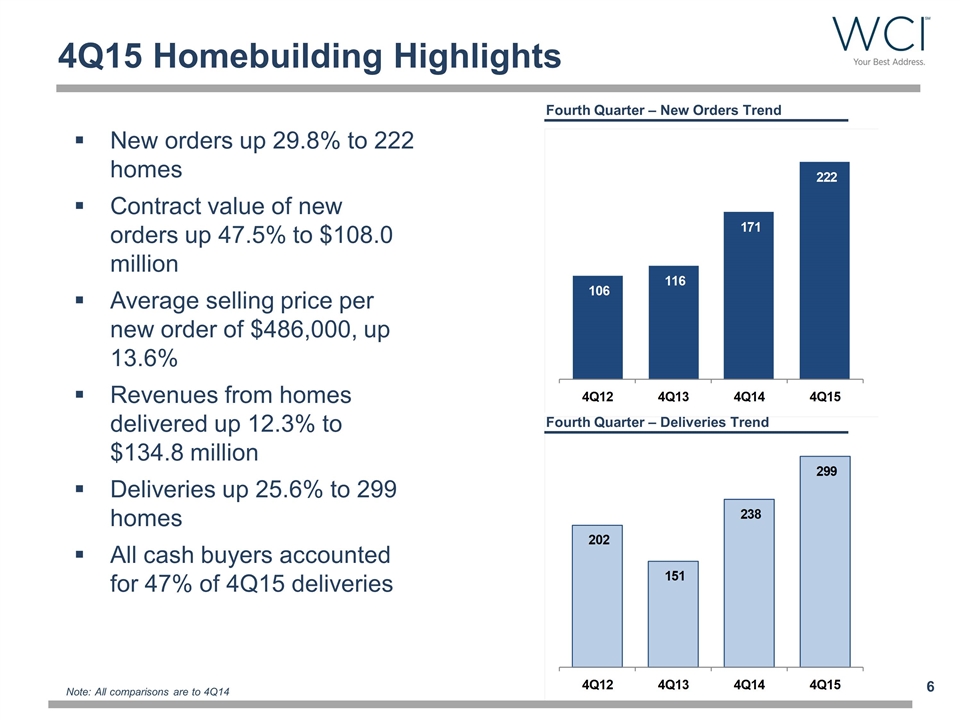
4Q15 Homebuilding Highlights New orders up 29.8% to 222 homes Contract value of new orders up 47.5% to $108.0 million Average selling price per new order of $486,000, up 13.6% Revenues from homes delivered up 12.3% to $134.8 million Deliveries up 25.6% to 299 homes All cash buyers accounted for 47% of 4Q15 deliveries Fourth Quarter – New Orders Trend Fourth Quarter – Deliveries Trend Note: All comparisons are to 4Q14
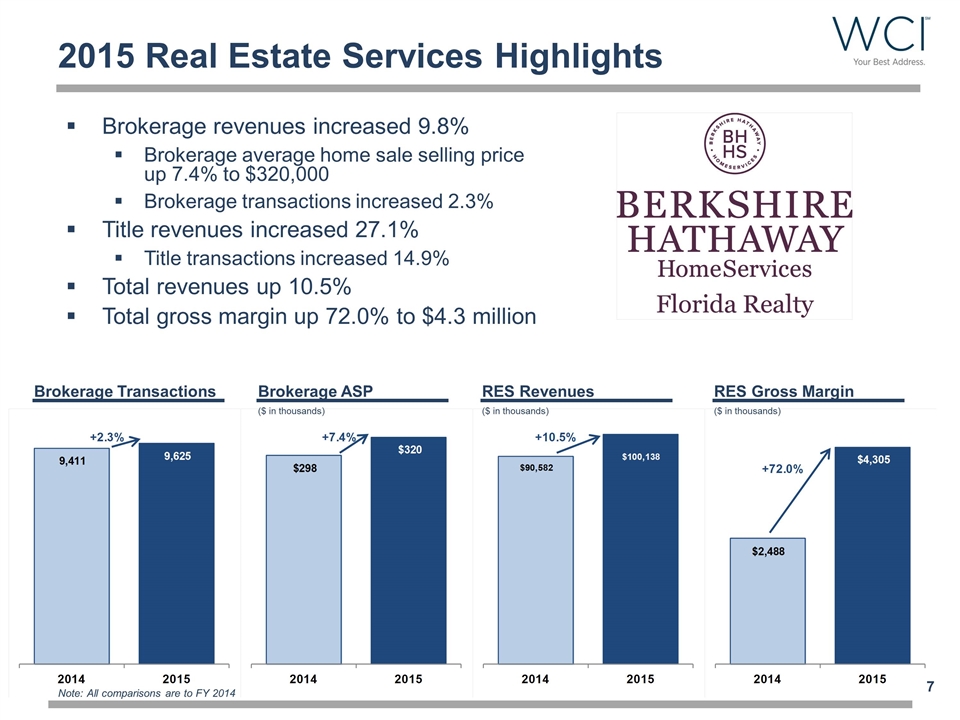
2015 Real Estate Services Highlights RES Revenues Brokerage Transactions Brokerage ASP Brokerage revenues increased 9.8% Brokerage average home sale selling price up 7.4% to $320,000 Brokerage transactions increased 2.3% Title revenues increased 27.1% Title transactions increased 14.9% Total revenues up 10.5% Total gross margin up 72.0% to $4.3 million RES Gross Margin Note: All comparisons are to FY 2014 ($ in thousands) ($ in thousands) ($ in thousands)
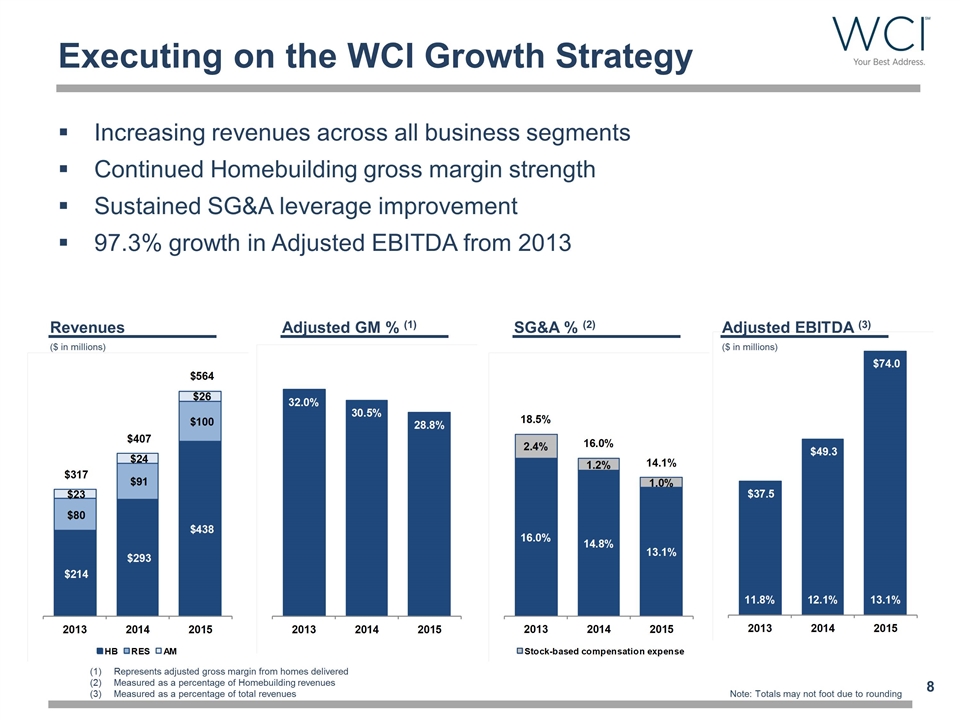
Executing on the WCI Growth Strategy Increasing revenues across all business segments Continued Homebuilding gross margin strength Sustained SG&A leverage improvement 97.3% growth in Adjusted EBITDA from 2013 Represents adjusted gross margin from homes delivered Measured as a percentage of Homebuilding revenues Measured as a percentage of total revenues Revenues ($ in millions) Adjusted EBITDA (3) SG&A % (2) Adjusted GM % (1) ($ in millions) Note: Totals may not foot due to rounding
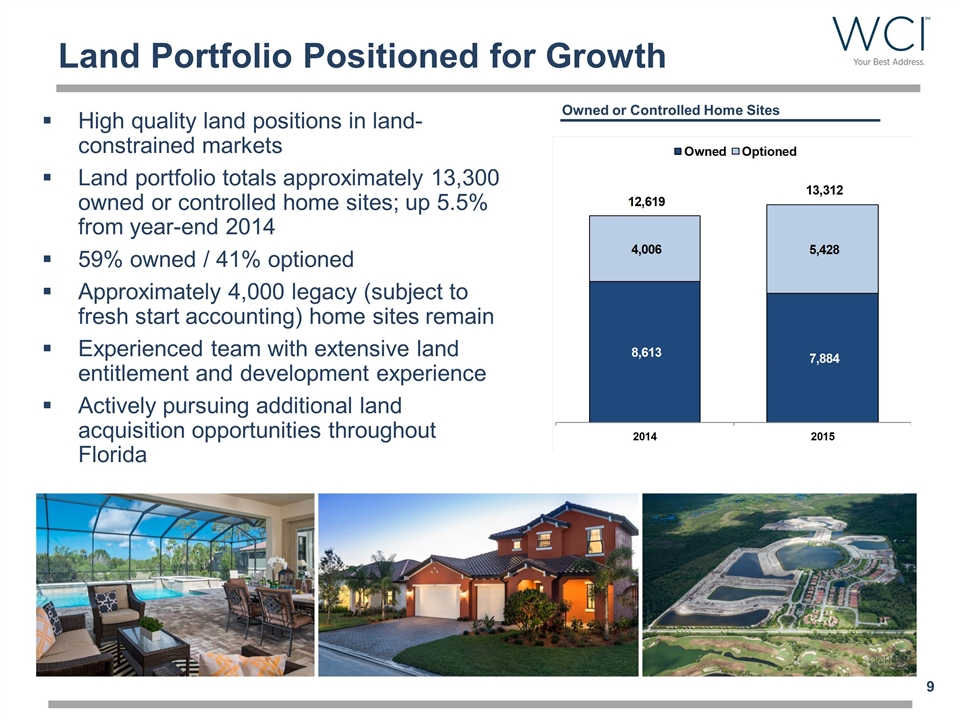
Land Portfolio Positioned for Growth High quality land positions in land-constrained markets Land portfolio totals approximately 13,300 owned or controlled home sites; up 5.5% from year-end 2014 59% owned / 41% optioned Approximately 4,000 legacy (subject to fresh start accounting) home sites remain Experienced team with extensive land entitlement and development experience Actively pursuing additional land acquisition opportunities throughout Florida Owned or Controlled Home Sites
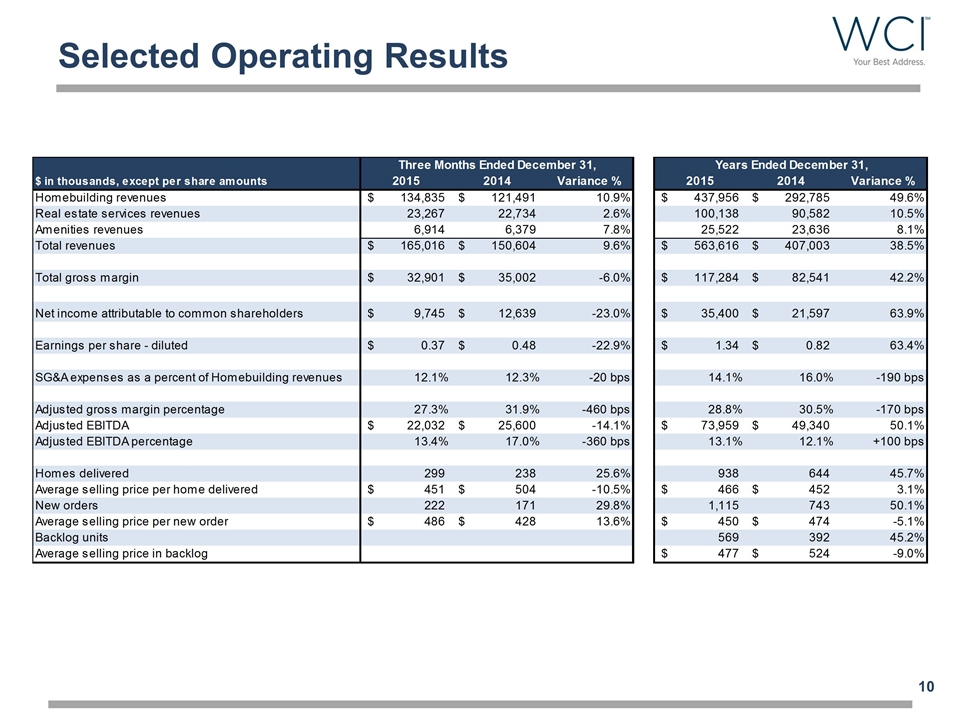
Selected Operating Results
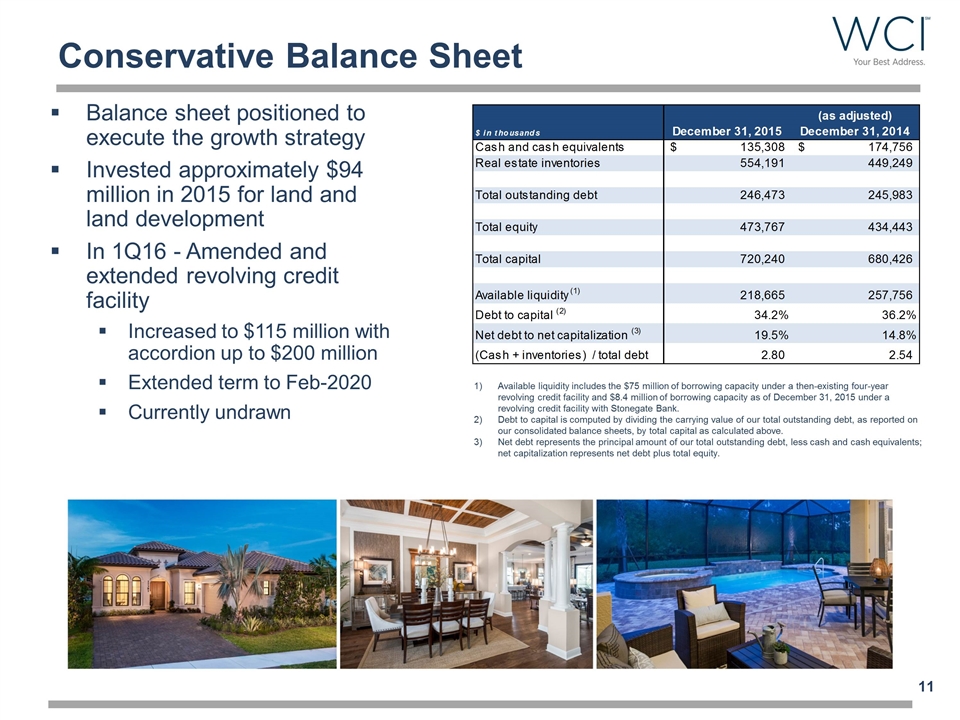
Conservative Balance Sheet Balance sheet positioned to execute the growth strategy Invested approximately $94 million in 2015 for land and land development In 1Q16 - Amended and extended revolving credit facility Increased to $115 million with accordion up to $200 million Extended term to Feb-2020 Currently undrawn Available liquidity includes the $75 million of borrowing capacity under a then-existing four-year revolving credit facility and $8.4 million of borrowing capacity as of December 31, 2015 under a revolving credit facility with Stonegate Bank. Debt to capital is computed by dividing the carrying value of our total outstanding debt, as reported on our consolidated balance sheets, by total capital as calculated above. Net debt represents the principal amount of our total outstanding debt, less cash and cash equivalents; net capitalization represents net debt plus total equity.
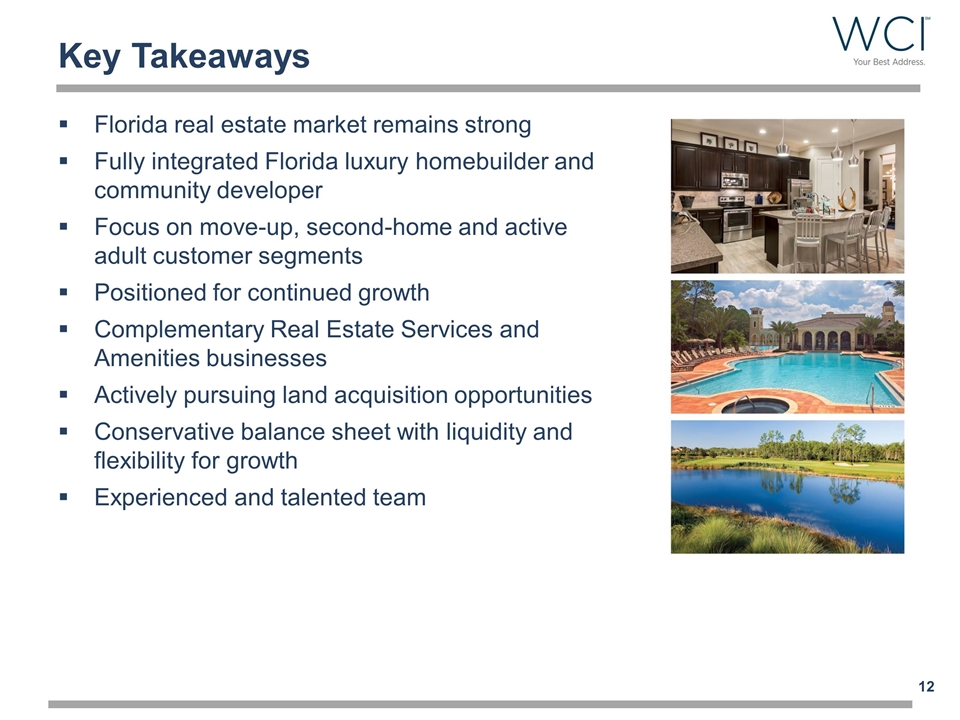
Key Takeaways Florida real estate market remains strong Fully integrated Florida luxury homebuilder and community developer Focus on move-up, second-home and active adult customer segments Positioned for continued growth Complementary Real Estate Services and Amenities businesses Actively pursuing land acquisition opportunities Conservative balance sheet with liquidity and flexibility for growth Experienced and talented team
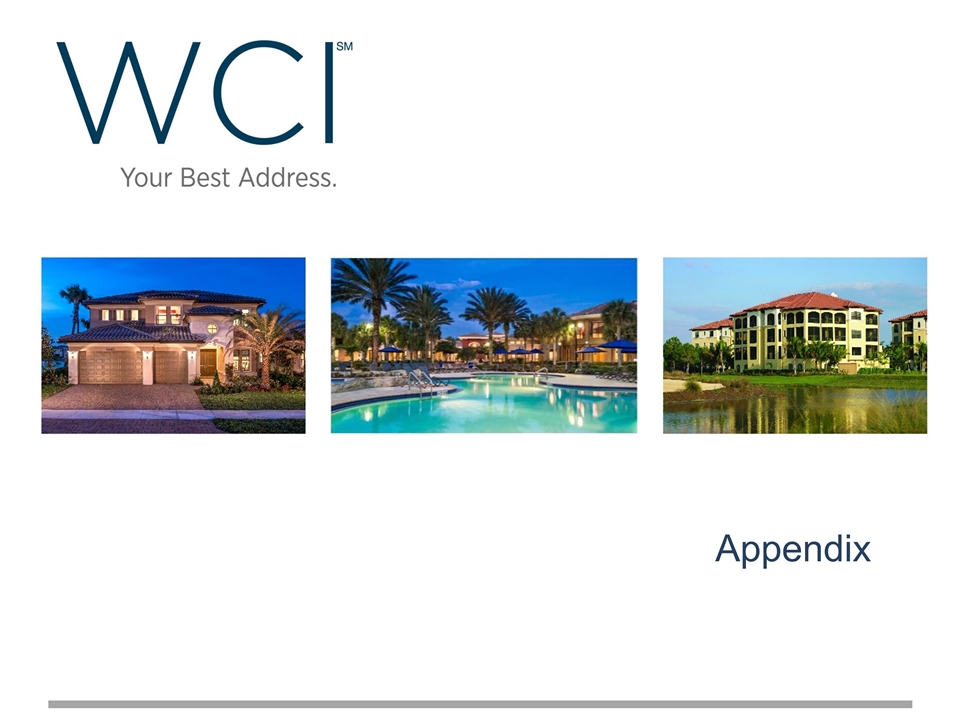
Appendix
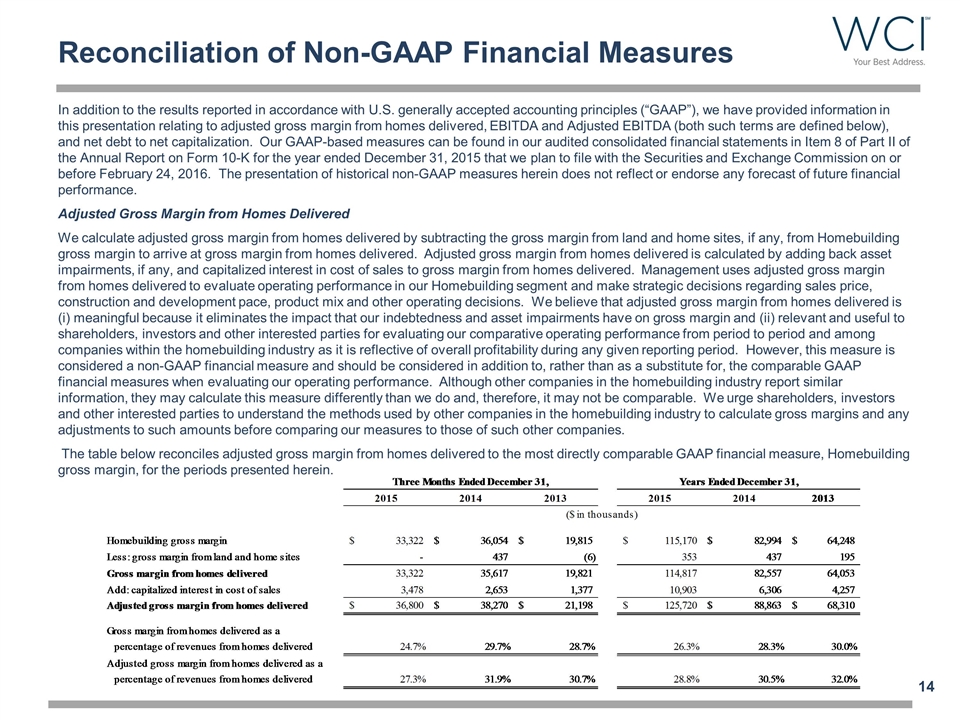
Reconciliation of Non-GAAP Financial Measures In addition to the results reported in accordance with U.S. generally accepted accounting principles (“GAAP”), we have provided information in this presentation relating to adjusted gross margin from homes delivered, EBITDA and Adjusted EBITDA (both such terms are defined below), and net debt to net capitalization. Our GAAP-based measures can be found in our audited consolidated financial statements in Item 8 of Part II of the Annual Report on Form 10-K for the year ended December 31, 2015 that we plan to file with the Securities and Exchange Commission on or before February 24, 2016. The presentation of historical non-GAAP measures herein does not reflect or endorse any forecast of future financial performance. Adjusted Gross Margin from Homes Delivered We calculate adjusted gross margin from homes delivered by subtracting the gross margin from land and home sites, if any, from Homebuilding gross margin to arrive at gross margin from homes delivered. Adjusted gross margin from homes delivered is calculated by adding back asset impairments, if any, and capitalized interest in cost of sales to gross margin from homes delivered. Management uses adjusted gross margin from homes delivered to evaluate operating performance in our Homebuilding segment and make strategic decisions regarding sales price, construction and development pace, product mix and other operating decisions. We believe that adjusted gross margin from homes delivered is (i) meaningful because it eliminates the impact that our indebtedness and asset impairments have on gross margin and (ii) relevant and useful to shareholders, investors and other interested parties for evaluating our comparative operating performance from period to period and among companies within the homebuilding industry as it is reflective of overall profitability during any given reporting period. However, this measure is considered a non-GAAP financial measure and should be considered in addition to, rather than as a substitute for, the comparable GAAP financial measures when evaluating our operating performance. Although other companies in the homebuilding industry report similar information, they may calculate this measure differently than we do and, therefore, it may not be comparable. We urge shareholders, investors and other interested parties to understand the methods used by other companies in the homebuilding industry to calculate gross margins and any adjustments to such amounts before comparing our measures to those of such other companies. The table below reconciles adjusted gross margin from homes delivered to the most directly comparable GAAP financial measure, Homebuilding gross margin, for the periods presented herein.
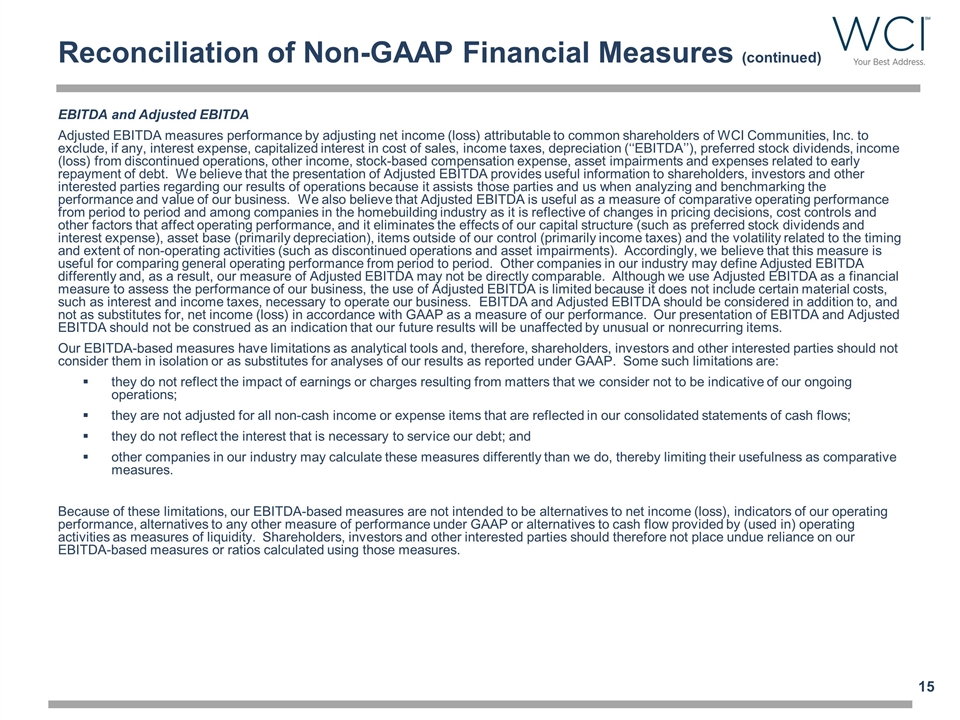
Reconciliation of Non-GAAP Financial Measures (continued) EBITDA and Adjusted EBITDA Adjusted EBITDA measures performance by adjusting net income (loss) attributable to common shareholders of WCI Communities, Inc. to exclude, if any, interest expense, capitalized interest in cost of sales, income taxes, depreciation (‘‘EBITDA’’), preferred stock dividends, income (loss) from discontinued operations, other income, stock-based compensation expense, asset impairments and expenses related to early repayment of debt. We believe that the presentation of Adjusted EBITDA provides useful information to shareholders, investors and other interested parties regarding our results of operations because it assists those parties and us when analyzing and benchmarking the performance and value of our business. We also believe that Adjusted EBITDA is useful as a measure of comparative operating performance from period to period and among companies in the homebuilding industry as it is reflective of changes in pricing decisions, cost controls and other factors that affect operating performance, and it eliminates the effects of our capital structure (such as preferred stock dividends and interest expense), asset base (primarily depreciation), items outside of our control (primarily income taxes) and the volatility related to the timing and extent of non-operating activities (such as discontinued operations and asset impairments). Accordingly, we believe that this measure is useful for comparing general operating performance from period to period. Other companies in our industry may define Adjusted EBITDA differently and, as a result, our measure of Adjusted EBITDA may not be directly comparable. Although we use Adjusted EBITDA as a financial measure to assess the performance of our business, the use of Adjusted EBITDA is limited because it does not include certain material costs, such as interest and income taxes, necessary to operate our business. EBITDA and Adjusted EBITDA should be considered in addition to, and not as substitutes for, net income (loss) in accordance with GAAP as a measure of our performance. Our presentation of EBITDA and Adjusted EBITDA should not be construed as an indication that our future results will be unaffected by unusual or nonrecurring items. Our EBITDA-based measures have limitations as analytical tools and, therefore, shareholders, investors and other interested parties should not consider them in isolation or as substitutes for analyses of our results as reported under GAAP. Some such limitations are: they do not reflect the impact of earnings or charges resulting from matters that we consider not to be indicative of our ongoing operations; they are not adjusted for all non-cash income or expense items that are reflected in our consolidated statements of cash flows; they do not reflect the interest that is necessary to service our debt; and other companies in our industry may calculate these measures differently than we do, thereby limiting their usefulness as comparative measures. Because of these limitations, our EBITDA-based measures are not intended to be alternatives to net income (loss), indicators of our operating performance, alternatives to any other measure of performance under GAAP or alternatives to cash flow provided by (used in) operating activities as measures of liquidity. Shareholders, investors and other interested parties should therefore not place undue reliance on our EBITDA-based measures or ratios calculated using those measures.
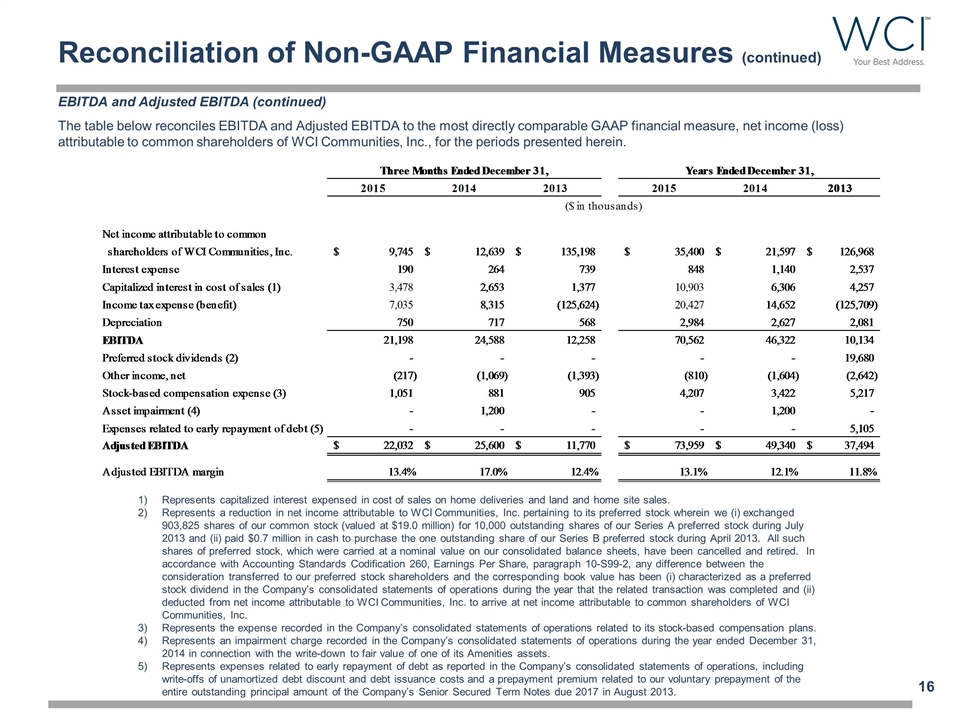
Reconciliation of Non-GAAP Financial Measures (continued) EBITDA and Adjusted EBITDA (continued) The table below reconciles EBITDA and Adjusted EBITDA to the most directly comparable GAAP financial measure, net income (loss) attributable to common shareholders of WCI Communities, Inc., for the periods presented herein. Represents capitalized interest expensed in cost of sales on home deliveries and land and home site sales. Represents a reduction in net income attributable to WCI Communities, Inc. pertaining to its preferred stock wherein we (i) exchanged 903,825 shares of our common stock (valued at $19.0 million) for 10,000 outstanding shares of our Series A preferred stock during July 2013 and (ii) paid $0.7 million in cash to purchase the one outstanding share of our Series B preferred stock during April 2013. All such shares of preferred stock, which were carried at a nominal value on our consolidated balance sheets, have been cancelled and retired. In accordance with Accounting Standards Codification 260, Earnings Per Share, paragraph 10-S99-2, any difference between the consideration transferred to our preferred stock shareholders and the corresponding book value has been (i) characterized as a preferred stock dividend in the Company’s consolidated statements of operations during the year that the related transaction was completed and (ii) deducted from net income attributable to WCI Communities, Inc. to arrive at net income attributable to common shareholders of WCI Communities, Inc. Represents the expense recorded in the Company’s consolidated statements of operations related to its stock-based compensation plans. Represents an impairment charge recorded in the Company’s consolidated statements of operations during the year ended December 31, 2014 in connection with the write-down to fair value of one of its Amenities assets. Represents expenses related to early repayment of debt as reported in the Company’s consolidated statements of operations, including write-offs of unamortized debt discount and debt issuance costs and a prepayment premium related to our voluntary prepayment of the entire outstanding principal amount of the Company’s Senior Secured Term Notes due 2017 in August 2013.
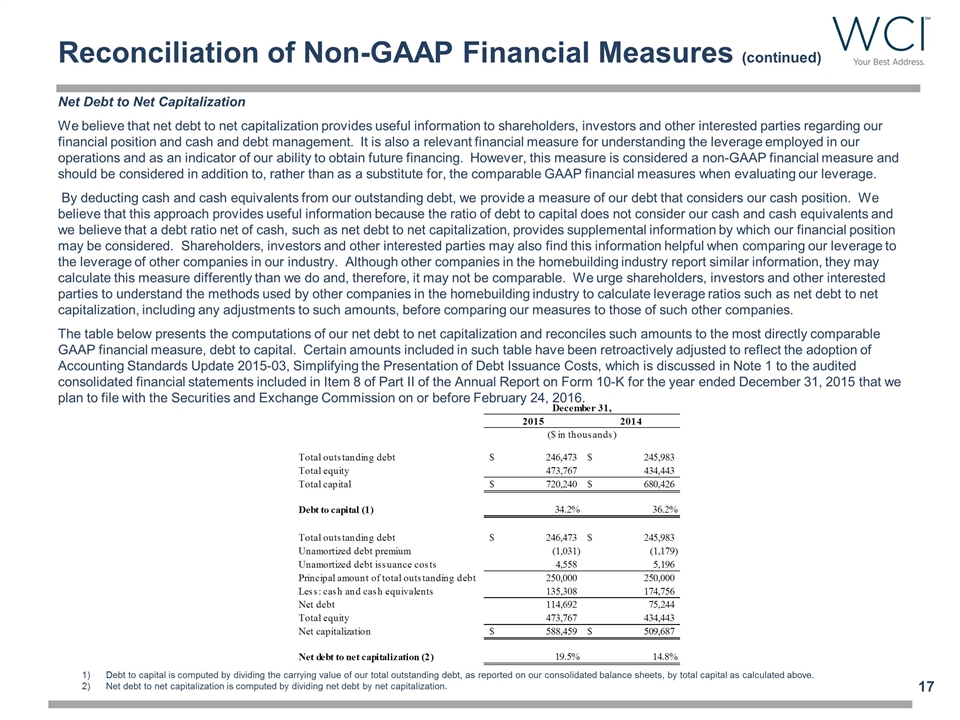
Reconciliation of Non-GAAP Financial Measures (continued) Net Debt to Net Capitalization We believe that net debt to net capitalization provides useful information to shareholders, investors and other interested parties regarding our financial position and cash and debt management. It is also a relevant financial measure for understanding the leverage employed in our operations and as an indicator of our ability to obtain future financing. However, this measure is considered a non-GAAP financial measure and should be considered in addition to, rather than as a substitute for, the comparable GAAP financial measures when evaluating our leverage. By deducting cash and cash equivalents from our outstanding debt, we provide a measure of our debt that considers our cash position. We believe that this approach provides useful information because the ratio of debt to capital does not consider our cash and cash equivalents and we believe that a debt ratio net of cash, such as net debt to net capitalization, provides supplemental information by which our financial position may be considered. Shareholders, investors and other interested parties may also find this information helpful when comparing our leverage to the leverage of other companies in our industry. Although other companies in the homebuilding industry report similar information, they may calculate this measure differently than we do and, therefore, it may not be comparable. We urge shareholders, investors and other interested parties to understand the methods used by other companies in the homebuilding industry to calculate leverage ratios such as net debt to net capitalization, including any adjustments to such amounts, before comparing our measures to those of such other companies. The table below presents the computations of our net debt to net capitalization and reconciles such amounts to the most directly comparable GAAP financial measure, debt to capital. Certain amounts included in such table have been retroactively adjusted to reflect the adoption of Accounting Standards Update 2015-03, Simplifying the Presentation of Debt Issuance Costs, which is discussed in Note 1 to the audited consolidated financial statements included in Item 8 of Part II of the Annual Report on Form 10-K for the year ended December 31, 2015 that we plan to file with the Securities and Exchange Commission on or before February 24, 2016. Debt to capital is computed by dividing the carrying value of our total outstanding debt, as reported on our consolidated balance sheets, by total capital as calculated above. Net debt to net capitalization is computed by dividing net debt by net capitalization.
